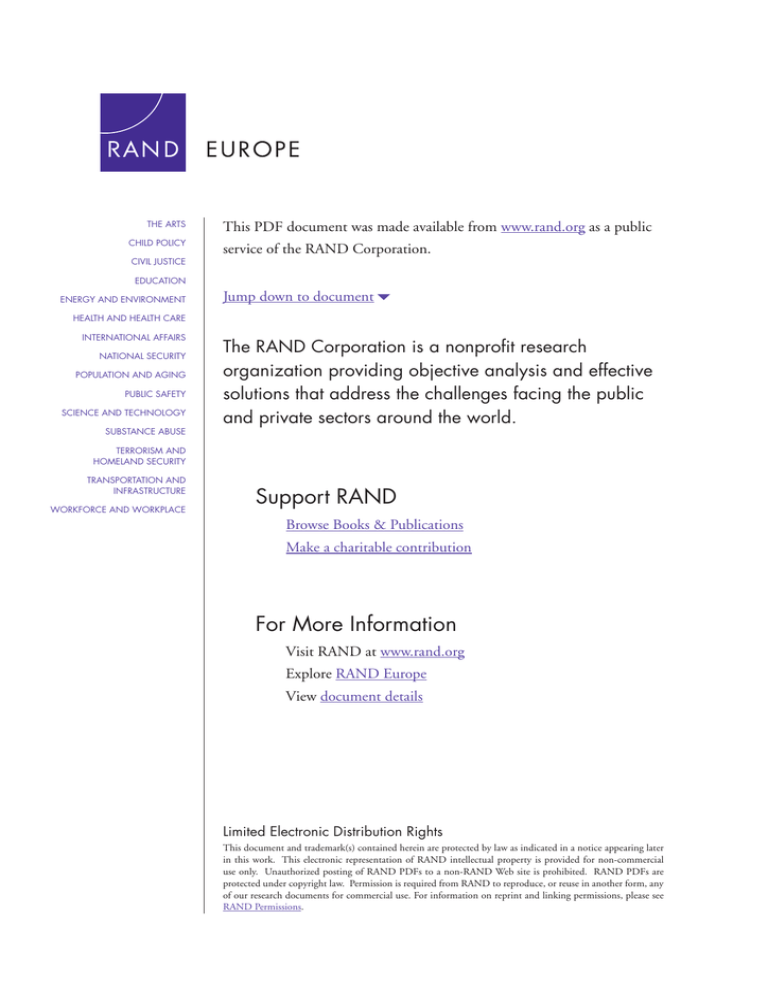
THE ARTS
CHILD POLICY
CIVIL JUSTICE
This PDF document was made available from www.rand.org as a public
service of the RAND Corporation.
EDUCATION
ENERGY AND ENVIRONMENT
Jump down to document6
HEALTH AND HEALTH CARE
INTERNATIONAL AFFAIRS
NATIONAL SECURITY
POPULATION AND AGING
PUBLIC SAFETY
SCIENCE AND TECHNOLOGY
SUBSTANCE ABUSE
The RAND Corporation is a nonprofit research
organization providing objective analysis and effective
solutions that address the challenges facing the public
and private sectors around the world.
TERRORISM AND
HOMELAND SECURITY
TRANSPORTATION AND
INFRASTRUCTURE
WORKFORCE AND WORKPLACE
Support RAND
Browse Books & Publications
Make a charitable contribution
For More Information
Visit RAND at www.rand.org
Explore RAND Europe
View document details
Limited Electronic Distribution Rights
This document and trademark(s) contained herein are protected by law as indicated in a notice appearing later
in this work. This electronic representation of RAND intellectual property is provided for non-commercial
use only. Unauthorized posting of RAND PDFs to a non-RAND Web site is prohibited. RAND PDFs are
protected under copyright law. Permission is required from RAND to reproduce, or reuse in another form, any
of our research documents for commercial use. For information on reprint and linking permissions, please see
RAND Permissions.
This product is part of the RAND Corporation technical report series. Reports may
include research findings on a specific topic that is limited in scope; present discussions of the methodology employed in research; provide literature reviews, survey
instruments, modeling exercises, guidelines for practitioners and research professionals, and supporting documentation; or deliver preliminary findings. All RAND
reports undergo rigorous peer review to ensure that they meet high standards for research quality and objectivity.
Radicalization or
Rehabilitation
Understanding the challenge of
extremist and radicalized prisoners
Greg Hannah, Lindsay Clutterbuck, Jennifer Rubin
Prepared for the RAND Corporation
The research described in this report was prepared for and funded by the R AND
Corporation.
The RAND Corporation is a nonprofit research organization providing objective analysis
and effective solutions that address the challenges facing the public and private sectors
around the world. RAND’s publications do not necessarily reflect the opinions of its
research clients and sponsors.
R® is a registered trademark.
© Copyright 2008 RAND Corporation
All rights reserved. No part of this book may be reproduced in any form by any electronic or
mechanical means (including photocopying, recording, or information storage and retrieval)
without permission in writing from RAND.
Published 2008 by the RAND Corporation
1776 Main Street, P.O. Box 2138, Santa Monica, CA 90407-2138
1200 South Hayes Street, Arlington, VA 22202-5050
4570 Fifth Avenue, Suite 600, Pittsburgh, PA 15213-2665
Westbrook Centre, Milton Road, Cambridge CB4 1YG, United Kingdom
RAND URL: http://www.rand.org
RAND Europe URL: http://www.rand.org/randeurope
To order RAND documents or to obtain additional information, contact
Distribution Services: Telephone: (310) 451-7002;
Fax: (310) 451-6915; Email: order@rand.org
Summary
The radicalization of young Muslims has become an issue of high priority to public policymakers in the UK, Europe and beyond. The deadly attacks in Madrid in 2004 and on the
London transport network in July 2005 highlighted the threat posed by small groups of
violent, radicalized individuals. Consequently, focus is currently turning to questions about
the challenge of radicalization – its precursors, processes, nodes (or physical environments)
and operational characteristics, and the potential for de-radicalizing such individuals.
Among the nodes for radicalization, three physical venues are thought to be of concern:
radicalized mosques, educational establishments (notably universities) and prisons. In
particular, radicalization and extremist activity in prisons has increasingly been highlighted
as of being of concern in recent official statements surrounding the issue (for example, see
House of Commons 2006, 2007a).
This study therefore seeks to explore the issue of radicalization and extremist activity in the
prison environment. Using a combination of prison theory, historical examples and
contemporary open source material, this report seeks to identify lessons from previous
instances of dealing with extremist prisoners. It is hoped that these lessons may provide
insights about the challenges posed by the increasing number of violent imprisoned
jihadists.
There appear to be considerable overlaps between the historical precedents for dealing with
prisoners in earlier conflicts, such as that in Northern Ireland, and the subject of this study.
A substantial proportion of the lessons already identified from the management of
extremist prisoners are therefore likely to remain valid. However, there are some aspects of
the contemporary situation that appear to require greater examination and understanding.
A notable difference between the examples of Irish Republican and Basque groups and
contemporary violent jihadists concerns their respective attitudes to the recruitment of new
members in prison. The nationalist groups deliberately avoided such recruitment, while
imprisoned violent jihadists appear to regard recruitment in their prisons as a prime
objective. This report draws a number of conclusions about what is and (arguably, more
importantly) what is not known about the nature and extent of the problem. It highlights a
number of areas that appear to require additional research and exploration.
It is difficult to assess the extent of the problem
Due to the lack of open sources and reluctance on the part of the authorities to discuss
these issues, it is not currently possible to draw any definitive conclusions about the extent
of violent jihadist radicalization and recruitment in European prisons. While there is some
evidence that problem exists, without greater access to security and prison authorities and,
ix
Radicalization or Rehabilitation: Understanding the challenge of extremist and radicalized prisoners
perhaps, to the prisons themselves, it will remain impossible to quantify its extent.
However, it seems reasonable to conclude that, as the number of violent jihadist prisoners
grows, so too will the potential for future challenges in managing them.
Radicalization of prisoners is neither new nor unique
The examples examined in this study show that the potential for imprisoned individuals to
adopt new and, in some cases, extremist or radicalized beliefs, is not a new phenomenon,
nor is it exclusive to contemporary violent jihadists. A number of organizations have
demonstrated how the prison system is used as a source of new recruits and as a base of
power. By examining these and other precedents we may gain a greater understanding of
how the radicalization process operates in the prison environment.
Imprisonment may enhance vulnerability to radicalization
Imprisonment may increase a prisoner’s susceptibility to adopting new and radicalized
ideas or beliefs. This is referred to as a “cognitive opening”. There are striking similarities
between what are believed to be the psychological experiences that make young Muslims
susceptible to radicalization and the psychological impact of imprisonment on individuals
in general. These experiences include: undergoing a crisis of self-understanding that
challenges or even destroys your conception of the self, experiencing acute feelings of
rejection by your native or adopted society and seeking to cope by adopting a new selfidentity or self-belief, which may be achieved by adopting a new belief structure (religious
or otherwise) and being assimilated into a new, inclusive and frequently protective, group
identity. Thus, placing young Muslims (who may already be vulnerable to radicalizing
influences) in a prison environment, with all its accompanying psychological and physical
dangers may well compound their vulnerability to radicalization. However, it must also be
recognized that adopting new and radicalized beliefs may be only one potential pathway
for prisoners. Some may seek solace in religion, which may be literalist in its interpretation,
but does not necessarily indicate that the prisoner has become a potentially violent
extremist. The apparent tendency of some prisoners to convert or revert to religious beliefs
highlights the importance of preventing extremists from spreading their ideology via
religious services or places of worship in prison. This reinforces the importance of
initiatives such as that taken by the UK Prison Service to provide specialist training to
prison imams.
Radicalization is one element in a spectrum of potential extremist activity
Radicalized and extremist prisoners may engage in a wide range of activities in prison.
Some of these activities may be normal within prison walls, while others may be the result
of active resistance. Such activities may simply involve forming into groups of like-minded
individuals for self-protection or support, but others may be less benign, such as staging
protests and hunger strikes or violent resistance in the form of riots and escapes. Prison and
security authorities may have anticipate the possibility that, as the number of violent
jihadist prisoners grows, a more cohesive organization may evolve in prisons that will seek
to disrupt or subvert the custodial regime.
Greater understanding of the nature of the problem is required
One aspect of extremist prisoner organizations, such as the prison elements of Provisional
Irish Republican Army (PIRA) or the Euskadi Ta Askatasuna (ETA), that made them easier
x
RAND Europe
Summary
to identify, understand and counter was their hierarchical or paramilitary structures.
Identifying who was in control and discerning what the roles of the different prisoners
were was easy for the prison authorities. This is not the case with violent jihadist prisoners
who, far from revealing their organizational allegiances and activities, may seek to remain
covert. The clandestine nature of their operation makes it harder to distinguish which
prisoners are extremists in the general prisoner population. Cultural differences between
the prisoners and those who guard them make this perception harder still. Religiosity is an
increasingly unreliable indicator of extremist or radicalized behaviour and it may be
counter-productive to assume that it is. Further research may useful for developing a better
understanding of what indicators, if any, may point to influential extremist or radicalizing
activity in prisons.
There are options for containing extremist prisoners
One of the problems faced by those seeking to manage extremist prisoners is deciding
where and how to contain them. The two primary options are to concentrate them in one
or a few prisons or to disperse them throughout the prison system. Both options have
advantages and disadvantages. From a resource perspective concentration is beneficial, as
the necessary high security resources (perhaps including intelligence-gathering capabilities,
using specialized personnel such as linguists, staff training and so on) are needed in only a
few locations. However, concentration can also have problematic consequences. In the
Maze Prison in Northern Ireland, for example, opposing paramilitary factions of prisoners
effectively took control of their prison wings, segregating themselves from the other side
and other ordinary prisoners. The paramilitary prisoners could then more readily engage in
a range of subversive and violent activities. Those engaged in violent jihad in the UK are
typically not part of an organized, hierarchical group; instead they are made up of small,
loosely affiliated cells and teams. However, it is possible that if such individuals are
concentrated, their loose networks may consolidate into a more solid and organized form.
Dispersing extremist prisoners helps to prevents the formation of groups with strong
organizations and ties in a single prison and reduces the opportunities for their leaders to
maintain tight discipline and control over other prisoners. Dispersal also is likely to help
security by preventing small groups of extremist prisoners from plotting organized escape
attempts and from planning attacks or activities in or beyond the prison. Conversely,
dispersal may provide violent jihadist prisoners with access to a new pool of potential
recruits.
De-radicalization of extremist prisoners may be possible
In a number of countries, perhaps following the recognition by the authorities of the
potential consequences of large numbers of violent, radicalized individuals being
concentrated in prisons for many years, programmes for the de-radicalization of prisoners
have been developed. The efforts of Singapore, Saudi Arabia and Yemen have received
considerable attention but is difficult to assess the level of success achieved by these
programmes. The authorities in Singapore have released at least three former Jemaah
Islamyia members as a result of their rehabilitation efforts. It is reported that since 2004
some 2,000 prisoners have participated in the Saudi Arabian programme, of whom roughly
700 have been released. In the case of Yemen some 364 suspected militants were released
before the programme’s effectiveness was called into question.
xi
Radicalization or Rehabilitation: Understanding the challenge of extremist and radicalized prisoners
The prisoners targeted have several opportunities to abuse such programmes. The Yemeni
example appears to demonstrate this, as it resulted in releasing prisoners who returned to
their extremist ways. It would be difficult for Western, non-Muslim governments to create
such programmes without the active support of leading religious authorities. In Singapore
the cooperation between the secular authority and local religious leaders appears to have
helped their rehabilitation programme to succeed. However, these schemes mentioned
above, and others, have been in operation for relatively short periods of time and therefore
it is too early judge their overall effectiveness. Thus, further research and evaluation may
lead to greater understanding of these efforts and the effectiveness of different methods.
Preventative and resettlement initiatives require greater attention
Imprisonment provides many of the social and psychological conditions for subsequent
criminalization and potentially for radicalization and future extremist activity. Prisoners
experience the denigration of the self, detachment from supportive social relationships,
exposure to harsh authority and day-to-day violence, and the affiliation with their peers
offers them an alternative, counter-cultural community of thought. The period postimprisonment thus poses further challenges for those seeking to counter radicalization.
One way of mitigating these challenges is to implement pre-release programmes that help
to prepare the prisoner to reintegrate back into the community and find work. This has
been found to have positive effects on offenders generally. However, there are likely to be
theological and political facets to prison programmes, which incorporate discussion groups
and links that continue when the prisoner is released into the community. This is
specifically to be avoided in countering Islamist radicalization.
Currently there is active and urgent debate and discussion about understanding how young
Muslims becoming offenders and reducing the likelihood of their doing so. The issues are
described at times in terms of counter-terrorism and at other times as concerning social
cohesion. This inconsistent use of language indicates a lack of conceptual clarity. While
counter-terrorism measures undoubtedly have a role to play in enhancing security,
understanding the experiences and disaffection of Muslim youth should be a separate
matter. Pursuing social cohesion means focusing on the diversity of communities,
including the whole range of religious, socio-economic and cultural groups, rather than
targeting one specific group. Targeting points of tension instead of individual groups and
seeking potential points of agreement and consensus about desirable ways of living
peacefully together, may be more constructive than exhorting the moderate Muslim
community to condemn “Muslim terrorists” publicly. In pursuit of cohesion, inter-faith
dialogue has increasingly been considered a way forward to solicit the interest and support
of religious and cultural leaders in community dialogue. These leaders are key to
galvanizing more popular support that could help promote in their community a sense of
engagement, investment and belonging, a shared sense of purpose and positive and
supportive relationships. The implication is that individuals are thereby less likely to
experience crises of the self or to search for experiences that make them vulnerable to those
who may offer them alternative ideologies and practices and alternative courses of action,
including violence.
xii







